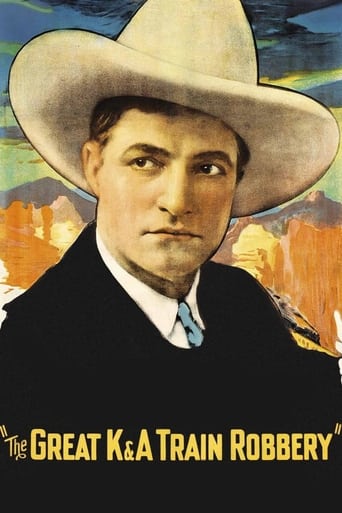Edgar Allan Pooh
. . . to focus on THE GREAT K & A TRAIN ROBBERY's Racism, Sexism, poor continuity, implausible plot, or clumsy acting. There's a saying that crops up in nearly every discussion of American Film: When in Doubt, Blame John Wayne. Before he kicked his bucket, Marion--as he was known in his K&A Days--apparently told this site (or its forerunner) that he was an "extra" among the cast for this Tom Mix vehicle. If so, his Face Time here would make most of Brit Director Alfred Hitchcock's famed but extremely fleeting cameo appearances look like featured roles by way of comparison with Marion's "work" in this flick and the rest of his first 20 or 30 claimed "parts." A VHS release from the 1900s for another alleged entry in Marion's filmography called THE DROP-KICK actually highlighted his literal face-in-the-crowd "role," which lasted approximately nine-tenths of one second. Though the box for that tape gave Marion equal billing with DROP-KICK's principle players, the case for K&A's 2003 Grapevine DVD release states that K&A was released in 1924, when 17-year-old Marion was still moping around in high school over his parent's ahead-of-their-time divorce, rather than in 1926, when a 19-year-old Marion had just dropped out of college due to what forensic psychologists have concluded was some sort of a male-on-male sexual assault by an unknown number of his college football teammates. (Only 2% of such incidents came to the attention of the not-always-sympathetic Authorities during the 1920s, and this small fraction that WAS reported nearly always involved one or more fatalities.) In other words, the Grapevine people are trying to avoid connecting this film with the sordid details of Marion's deflowering by NOT mentioning him at all, and purposely back-dating K&A's release to a year when Marion could NOT have been involved in it (which means that Grapevine might back-date its upcoming "public domain" release of GONE WITH THE WIND to 1858--BEFORE the novel was written, the battles were fought, Atlanta was burned, or movies were invented--if it felt a Politically Correct Need to do so).
Mike-764
Cullen, president of the K & A railroad, is at a loss to stop the robberies occurring on his line, even though he is unaware his secretary, Holt, is secretly tipping off the bandits with the shipments. Tom Morgan is called on to investigate, even though he needs to disguise himself as an outlaw in order infiltrate Tolfree's gang and hear their plans. When Cullen decides to send a shipment of bonds with him on another train, Holt tells Tolfree, who's going to lead his gang into robbery unless Tom's assistant, a hobo named Deluxe Harry, can relay the information to him in time. This is one of the more enjoyable Mix silents (of which there are still way too few) with a brisk pace, exciting chases, thrilling stunts throughout, and an exciting climax in an underground cave. A prologue to the film points out the exterior shots being in Glenwood Springs, Colorado, and they are very striking adding a lot of beauty to the picture. I think the film tried to be too mysterious with Mix' characterization and the character of the butler could have been eliminated since Deluxe Harry fit in well as the comic relief. Rating 8.
Bob F.
For those interested in American silent movie history, this film provides a rare look into movies as popular culture. Sadly, 95% of all silent fims made, have been lost through nitrate decomposition or outright destruction. This film made in 1926, is a rare survivor of the cowboy genre targeted for a youth audience. The plot to say the least is simplistic. But it was loaded wonderful stunts, constant action and spectacular scenery. Tom Mix was a hugh boxoffice draw, and as well know then, as was Charlie Chaplin, Douglas Fairbanks, or Mary Pickford. If you're curious to see a film that might well have thrilled your great grandfather and great grandmother when they were kids, check out *The Great A&K*.
John Seal
The story isn't much, but at a brisk 53 minutes you could do a lot worse. Some of the photography is actually quite stunning and impressive, and there's some good stunt work too. Sad to say the comedy relief from Curtis McHenry is particularly offensive to modern viewers, which may go some way to explaining this film's obscurity.


